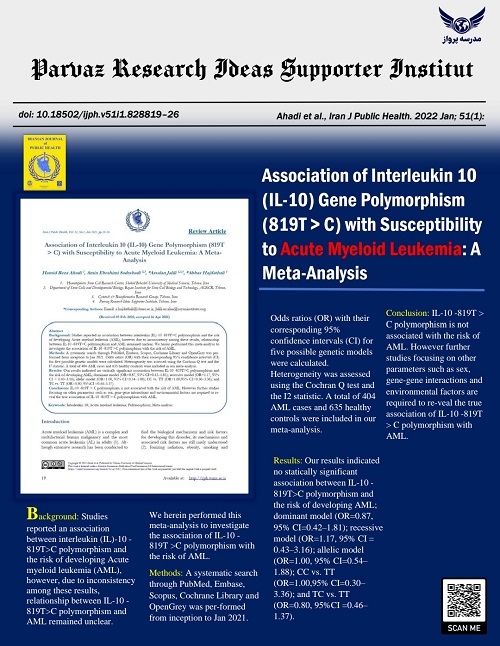
Background: Studies reported an association between interleukin (IL)-10 -819T>C polymorphism and the risk of developing Acute myeloid leukemia (AML), however due to inconsistency among these results, relationship between IL-10 -819T>C polymorphism and AML remained unclear. We herein performed this meta-analysis to investigate the association of IL-10 -819T >C polymorphism with the risk of AML.
Methods: A systematic search through PubMed, Embase, Scopus, Cochrane Library and OpenGrey was performed from inception to Jan 2021. Odds ratios (OR) with their corresponding 95% confidence intervals (CI) for five possible genetic models were calculated. Heterogeneity was assessed using the Cochran Q test and the I2 statistic. A total of 404 AML cases and 635 healthy controls were included in our meta-analysis.
Results: Our results indicated no statically significant association between IL-10 -819T>C polymorphism and the risk of developing AML; dominant model (OR=0.87, 95% CI=0.42–1.81); recessive model (OR=1.17, 95% CI = 0.43–3.16); allelic model (OR=1.00, 95% CI=0.54–1.88); CC vs. TT (OR=1.00,95% CI=0.30–3.36); and TC vs. TT (OR=0.80, 95%CI =0.46–1.37).
Conclusion: IL-10 -819T > C polymorphism is not associated with the risk of AML. However further studies focusing on other parameters such as sex, gene-gene interactions and environmental factors are required to reveal the true association of IL-10 -819T > C polymorphism with AML.

مدرسه پرواز از همه متخصصین زیست بالینی دعوت به عمل می آورد که از طریق بخش پروازی شو فعالیت خود را آغاز نمایند.
آدرس : تهران ، بزرگراه جلال آل احمد ، جنب بیمارستان دکتر شریعتی ، پلاک 10، پژوهشگاه علوم غدد دانشگاه علوم پزشکی تهران


دیدگاهتان را بنویسید